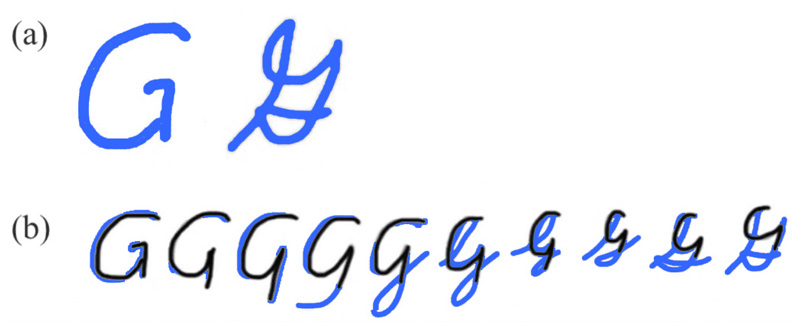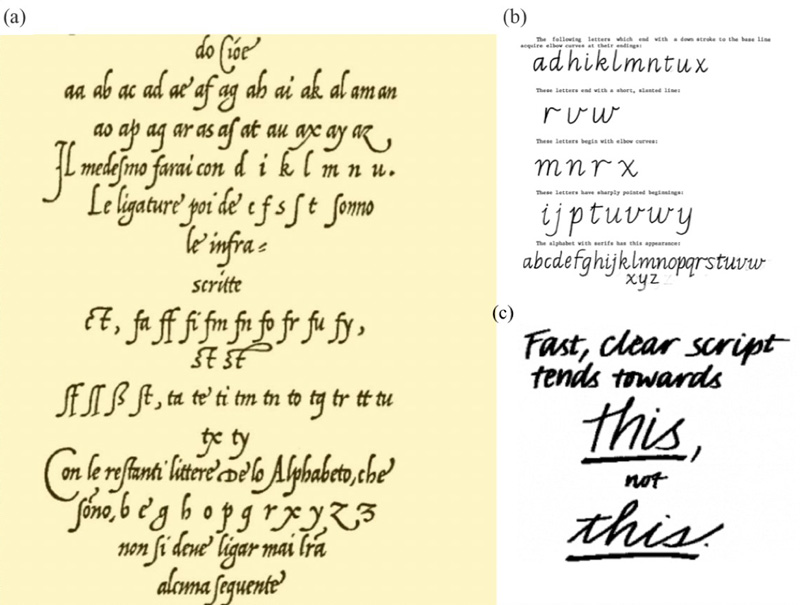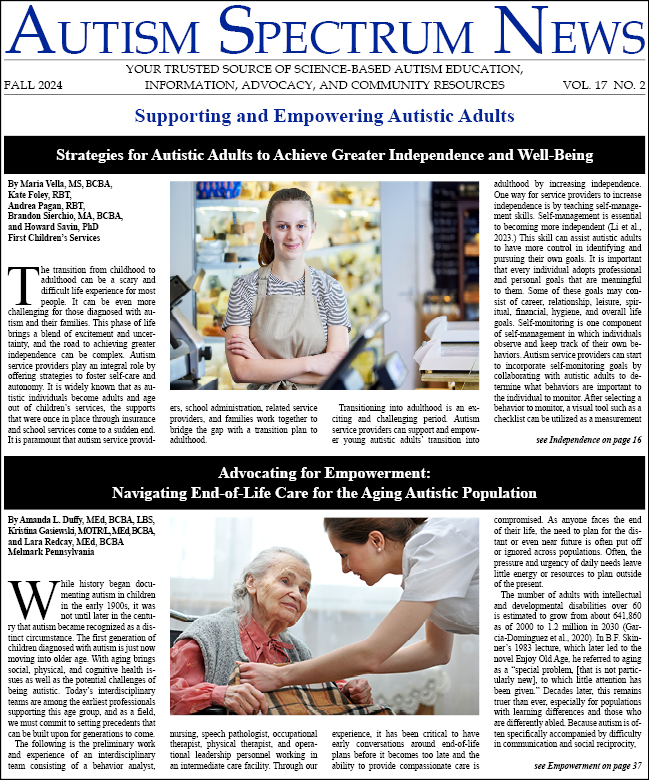Handwriting matters. Even those who never write must decipher others’ handwriting (many of us autistics never managed to read cursive: even if drilled intensively in copying it).
Although handwriting intervention efforts and studies typically focus on output, a larger problem (especially with cursive) may be input. While writing by hand may be avoided, reading cursive is sometimes unavoidable: yet few resources (and no current studies) address this issue, despite growing research on handwriting issues among autistic children, adolescents, and adults (Fuentes, Mostofsky, & Bastian, 2009; Fuentes, Mostofsky, & Bastian, 2010; Godde et al., 2018). Similarly, among current handwriting materials, only one textbook (Gladstone, 2021) and one set of handouts (Getty-Dubay, 2020) focus on cursive reading.
Traditionally, educators have expected cursive reading to emerge by hand-copying cursive, writing in cursive, and/or memorizing the many cursive letter-shapes which differ greatly (in conventional North American cursive styles) from printed letter-shapes. These approaches may not serve many autistic learners for the following reasons:
- Most autistics have motor issues that impede and/or distort handwritten output (Fuentes, Mostofsky, & Bastian, 2009; Fuentes, Mostofsky, & Bastian, 2010), often with perceptual issues which affect processing both the presented input and the expected output (Godde et al., 2018). Expecting cursive reading to arise from cursive writing may therefore be unrealistic for autistics.
- Autistics often do not generalize from known material to new material (De Marchena, Eigsti, & Yerys, 2015), so memorizing one cursive model does not guarantee recognizing letters in other cursive styles – or in real life handwritings: which differ, not only from textbook examples, but from one another.

Figure 1: Illustration from Gladstone, 2021, p. 92
These issues may be bypassed by techniques using pattern recognition, which is widely documented as an autistic strength (e.g., by Crespi (2021)). Such techniques (used in the two cursive reading resources cited above) teach shared design-features across numerous variants for each letter.
Though research has yet to be done, such techniques reportedly “have worked successfully with children, teens, and adults with and without disabilities” (National Autism Resources, 2021), suggesting universal design/mainstreaming applicability.
What about handwritten output? Despite electronics, handwriting is regaining attention, as research finds some cognitive advantages (e.g., literacy acquisition and factual retention) versus keyboarding (Harman-James, 2017; Peverly, 2006).
Although handwriting proficiency is often popularly equated with cursive, research since the 1980s suggests that most people (even most handwriting teachers) no longer write cursive but combine elements of manuscript and cursive. (Duvall, 1985; College Board, 2006; Zaner-Bloser, 2012), Later observations (Bara and Morin, 2013; Graham, Berninger and Weintraub, 1998) noted that the fastest, clearest hand writers typically join some (not all) letters (apparently avoiding motorically difficult joins) often producing print-like letters where these are motorically and/or visually simpler than their cursive counterparts. Similar features, interestingly, characterized the earliest published handwriting instruction in Western civilization 500 years ago (Arrighi, 1522) and are revised today in a category of handwriting model called “italic handwriting (Getty-Dubay, 2021; Barchowsky, 1999, Bennett, 2019).

Figure 2: Image (a) is a page from the first published handwriting textbook in Western civilization (Arrighi, 1522)
Images (b) and (c) are handwritten by two autistic adults who teach handwriting: (b) a teaching model (Bennett, 2019, p. 22)
and (c) everyday rapid handwriting (Gladstone, 2022)
At least two italic handwriting teachers and/resource creators have self-disclosed as autistic (Gladstone, 2022; J. Bennett; 2022, personal communication), suggesting that italic may be worth researching as an adaptive handwriting approach. The fact that Bennett additionally authored a best-selling calligraphy textbook (Bennet, 2007) suggests that autistics may not only succeed but excel in this area.
Kate Gladstone offers handwriting instruction/remediation services at HandwritingThatWorks.com and cursive reading resources at ReadCursiveFast.com. Her default e-mail address is Kate@ReadCursiveFast.com, and she can also be reached at 518-928-8101 (texts and mobile phone) or 518-482-6763 (landline phone).
References
Arrighi, Ludovico. (1522) La Operina. Rome: Ludovico Arrighi. Reprinted (with translation and annotations) 2007, Gunnlaugur S. E. Briem. Retrieved January 23, 2022 from https://sites.google.com/view/briem/free-books
Bara, F., Morin, M-F. (2013) Does the handwriting style learned in first grade determine the style used in the fourth and fifth grade, and influence handwriting speed and quality? Psychology in Schools, 50 (6), 2013. Retrieved Manch 7, 2021 from https://onlinelibrary.wiley.com/doi/abs/10.1002/pits.21691
Bennett, Jim. (2007) Calligraphy for Dummies. Hoboken [New Jersey]: For Dummies Press.
Bennett, Jim (2019), Modern Italic Handwriting: Teacher’s Guide. Poughkeepsie (New York): Jim Bennett. Retrieved March 2, 2022 from https://www.teacherspayteachers.com/Store/Italic-Handwriting-By-Jim-Bennett
College Board (2006). College-Bound Seniors: Total Group Profile Report. New York: The College Board. Retrieved January 21, 2007 from http://www.collegeboard.com/prod_downloads/about/news_info/cbsenior/yr2006/cbs-2006_release.pdf
Crespi B. (2021). Pattern Unifies Autism. Frontiers in Psychiatry, 12, 621659. Retrieved January 6, 2022 from https://doi.org/10.3389/fpsyt.2021.621659
De Marchena, A.B., Eigsti, IM. & Yerys, B.E. (2015). Brief Report: Generalization Weaknesses in Verbally Fluent Children and Adolescents with Autism Spectrum Disorder. Journal of Autism and Developmental Disorders, 45, 3370–3376.
Duvall, B, (1985). Evaluation of Eleventh Grade Students’ Writing Supports Teaching Italic Handwriting. Washington (DC): ERIC Clearinghouse.
Fuentes, C.T., Mostofsky, S.H., & Bastian, A.J. (2009). Children with autism show specific handwriting impairments. Neurology, 73, 1532 – 1537.
Fuentes, C.T., Mostofsky, S.H., & Bastian, A.J. (2010). Perceptual reasoning predicts handwriting impairments in adolescents with autism. Neurology, 75 (20): 1825-1829.
Getty, B, and Dubay, I. (2011) Write now: the Getty-Dubay program for handwriting success. Portland (Oregon): Allport Publications.
Getty-Dubay Handwriting. (2020) Supplements to the Getty-Dubay handwriting series: for reading looped cursive. Portland (Oregon): Allport Publications. Retrieved January 28, 2021 from https://handwritingsuccess.com/reading-looped-cursive-supplements/
Gladstone, K. (2018) Handwriting and the autism spectrum: notes from a survivor. Bethesda [Maryland]: Autism Society of America. Retrieved April 3, 2018 from https://www.autism-society.org/stories/handwriting-and-the-autism-spectrum-notes-from-a-survivor/
Gladstone, K. (2021) Read Cursive Fast. Benicia (California): National Autism Resources.
Gladstone, K. (2022) [Handwriting sample] Albany (New York): Kate Gladstone.
Godde, A., Tsao, R., Gepner, B., Tardif, C. (2018). Characteristics of handwriting quality and speed in adults with autism spectrum disorders. Research in Autism Spectrum Disorders, 46, 19-28. Retrieved March 1, 2022 from https://www.sciencedirect.com/science/article/pii/S1750946717301265)
Graham, S., Berninger, V., Weintraub. N. (1998) The relation between handwriting style and speed and legibility. Journal of Educational Research, 91, 5, 290-296. Retrieved January 19, 2022 from http://www.jstor.org/stable/pdfplus/27542168.pdf
James, K. H. (2017) The importance of handwriting experience on the development of the literate brain. Current Directions in Psychological Science, 26, 6, 502–508.
National Autism Resources. (2021, April 29). [Review of Read Cursive Fast]. Retrieved April 29, 2021 from National Autism Resources website: https://nationalautismresources.com/read-cursive-fast/
Peverly S. T. (2006). The importance of handwriting speed in adult writing. Developmental neuropsychology, 29(1), 197–216. Retrieved March 1, 2022 from https://doi.org/10.1207/s15326942dn2901_10
Samson, F., Mottron, L., Soulières, I., Zeffiro, T. (2011). Enhanced visual functioning in autism: an ALE meta-analysis. Human Brain Mapping, 33 (7), 1553-1581.
Zaner-Bloser Handwriting Education Summit Proceedings (2012). Summit Survey Statistics. Columbus (Ohio): Zaner-Bloser Handwriting. Retrieved January 18, 2022 from https://media.zaner-bloser.com/hw21summit/public/H2937N_post_event_stats.pdf






[…] Link to “Handwriting and the Autism Spectrum” by Kate Gladstone (published in AUTISM SPECTRUM NEWS for April 2022) LINK […]
Thank you, Doctor Sam!
Hi, fellow asd here to share my experience about this topic, my hand writing been so bad my whole life and now i know why, i just got diagnosed with ASD, as a kid i was looking at my peers handwriting and even the ones with lower grades than me had fantastic tip top shape writing than there was mine where in same sentence same letters were bigger or smaller in font size, some bent, some straight it was pure chaos, everything makes sense now
I stand ready to help you, if you wish. E-mail me through my web-site, ReadCursiveFast.com, mentioning AUTISM SPECTRUM NEWS so that I can find your letter easily and I’ll know who you are.
I’m a retired high school English teacher and I found that many of my neurotypical students were unable to decipher cursive writing.
READ CURSIVE FAST is going into its second printing — https://nationalautismresources.com/read-cursive-fast/
I’m trying to get diagnosed with ASD, i can write cursive, and if i take a long time, can sometimes read it. Could this be because my mom taught me cursive when I was in 1st grade? I do have a hard time reading it, but is it possible for an autistic person to read and write cursive, even if they don’t do it well?